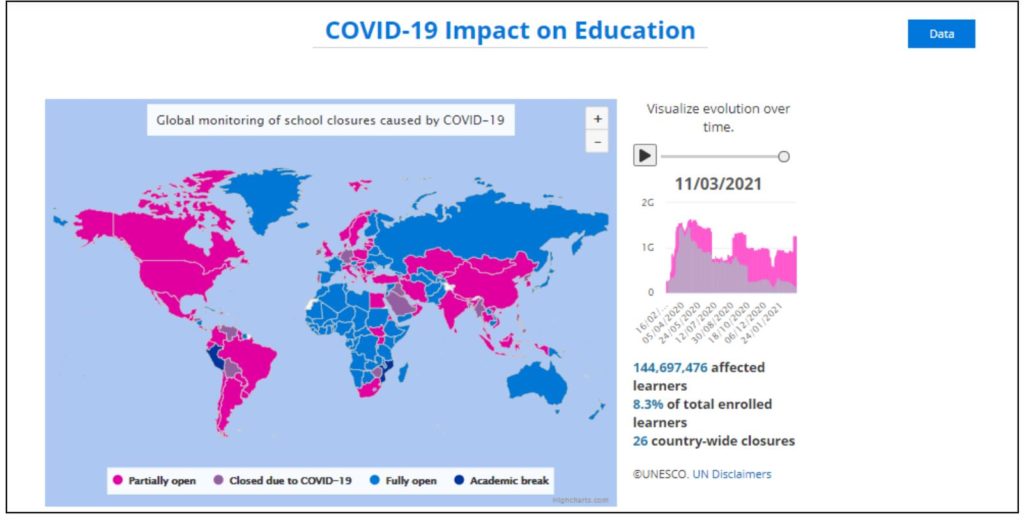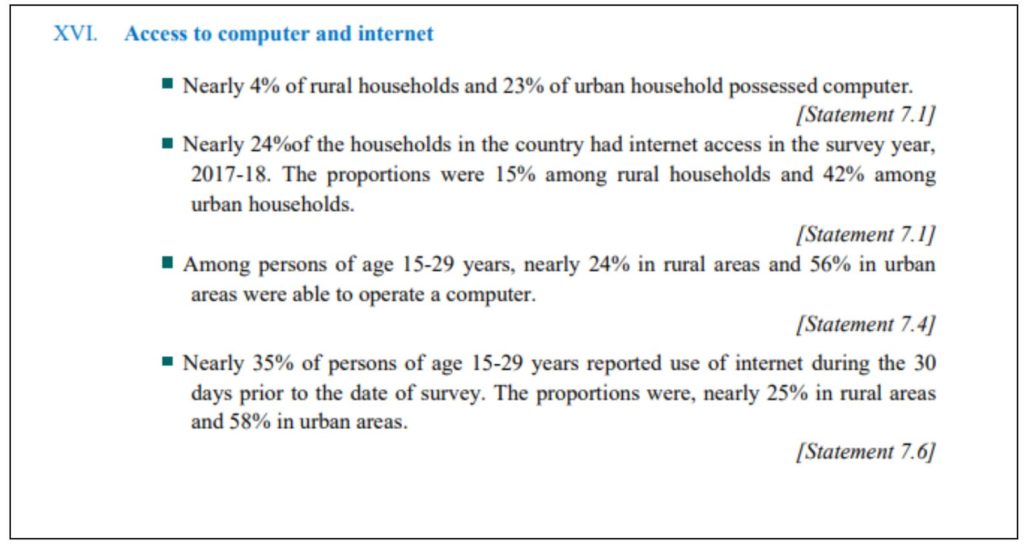One of the sectors that is badly affected by COVID-19 is the education sector. A recent UNICEF report states that about 888 million students continue to face some form of disruption around the world with full or partial school closures. Here is a review.
About a year ago, schools and other educational institutions across the world had to be shut to prevent the spread of the COVID-19 pandemic. Maintaining social distancing and hygiene practices among students was considered a difficult task because of which schools & educational institutions were almost the last things to open up in many countries.
On average, schools were shut for half the intended instruction time due to pandemic
According to a recent press release of UNICEF, globally, on average, schools were closed for half the intended instruction time. Over 214 million students from pre-primary to upper secondary education levels in 23 countries have missed at least three-quarters of their classroom instruction time in the past year. For more than 168 million children, schools have remained shut for almost an entire year because of the pandemic.
About 888 million continue to face disruptions in education due to full and partial school closures
Closure of schools was varied across regions. UNICEF noted that in 14 countries worldwide, schools have remained largely closed from March 2020 to February 2021. On average, in countries where schools were still closed as of 02 February 2021, nearly 80 percent of classroom instruction has been missed in the eleven-month period since March 2020. The majority of these were in the Latin America and the Caribbean region, followed by South Asia, Eastern, and Southern Africa regions. The report further adds that ‘according to latest data by UNESCO, more than 888 million children worldwide continue to face disruptions to their education due to full and partial school closures.’
Globally, the pandemic affected education of 1.5 billion students across 200 countries
As per the data compiled by UNICEF on the student population affected by the disruption caused due to COVID-19, more than 1.5 billion students in pre-primary, primary, lower secondary, and upper secondary levels of education were affected across 200 countries as of 02 March 2021. In India alone, more than 286 million students have been affected by partial or full school closures.
As of 02 February 2021, only 115 countries out of 210 have opened their schools fully including Russia, France, and Singapore. 50 countries, including India, have partially opened while 28 countries have completely shut schools due to COVID-19. For instance, in the UK, schools were fully open since September 2020, but following a resurgence of cases and discovery of new strain, the schools had to be shut completely following Christmas break. The government has yet again re-opened schools with stringent regulations from 08 March 2021.

Re-opening of schools must be prioritized to avert the adverse consequences on children
UNICEF has asked countries to try and keep schools open and also prioritize schools while considering re-opening because of the adverse consequences of school closures on children. School closures come with huge social and economic costs which would further affect the children of vulnerable groups. The World Bank has estimated that global school closures could result in a loss of at least US $10 trillion in lifetime earnings for this generation. Some of the consequences as noted are
- Not all students will be able to access online classes thereby aggravating the existing disparities in the education system.
- The overall growth and development of an individual that takes place in schools are lost and hence, the underprivileged learners lose opportunities beyond school. Social interaction with peers is also lost when children are confined to homes.
- Students don’t get the free nutritious food (like Mid-day meals in India) that is provided in schools which compromises their health.
- There is a possibility of increased drop-out rates when schools re-open. Sometimes, due to economic reasons, students may be forced into child labour to support the family. UNESCO has estimated that 11 million girls may not return to school, especially those aged between 12 to 17, in low and lower-income countries whereas boys are more at risk in upper-middle and high-income countries.
- Girls are at a higher risk of child marriage and early pregnancies. It is estimated that ten million additional child marriages may occur by the end of the decade due to the pandemic-induced economic stress, school closures, and parental deaths.
- Fairness in examinations, exposure to screens for a long period, technical difficulties, an intense requirement for self-learning, reduced interaction with teachers, are other concerns.
- A study on ‘Loss of Learning during the Pandemic’ covering 16,067 primary schoolchildren across five states, published by the Azim Premji University reveals that 92% of children on an average have lost at least one specific language ability from the previous year and 82% of children on an average have lost at least one specific mathematical ability from the previous year across all classes.
- The pressure on parents, teachers, and school systems is also more, and the financial loss only exacerbates the situation.
Pandemic has further deepened the ‘Digital Education divide’
Availability of internet, uninterrupted network, computers or laptops, and electricity, are major roadblocks when it comes to online classes. To deal with school closures, more than 90% of the countries implemented a remote learning policy in some form. That is, classes were taken online through video conferencing, aired in television, etc. However, UNICEF’s study found that at least 463 million students (about 31% of students) globally were cut off from education due to the lack of resources at home. About 147 million students of these were from South Asia. More than 70% of them were from rural areas and three-quarters of them came from the poorest 40% of households. The variation was huge among countries and within countries.
In India, the National Statistical Office in its NSS 75th round Report stated that only nearly 4% of the rural households in the country and 23% in the urban areas had access to computers and the internet. Only about 24% of households- 15% in rural areas and 42% in urban areas, had internet access as of 2017-18. Further, among persons aged 15-29 years, only about 24% in rural areas and 56% in urban areas were able to operate a computer.

Parliamentary Standing Committee recommended extending financial assistance and subsidies for students to overcome the digital divide
A parliamentary committee report released in December 2020, recommended that a scheme be formulated which provides financial assistance and low-cost subsidized devices such as tablets, smartphones, and computers to students, to address the digital divide between rural and urban households in India. It further suggested that the government must strengthen the IT infrastructure.
Most states have started re-opening schools in graded manner
The Central government had allowed the re-opening of schools in a graded manner in October 2020 and asked the state governments to take the decision based on the local conditions. Schools must follow the guidelines adopted from UNICEF to control the spread of the virus. Most states have re-opened schools, mainly for the higher secondary and secondary students in February 2021.
Education Ministry has issued guidelines to minimize the pandemic’s impact on students
The Ministry of Education, having observed the need for preventing increased drop-outs, lower enrolments, loss of learning, and deterioration in the gains made in providing universal access, quality, and equity in the recent years, has asked state governments to devise a strategy to deal with the same. Furthermore, the ministry has also issued guidelines for identification, admission, and continued education of migrant children.
Some of the steps to be taken during and while re-opening schools to minimize the pandemic’s impact on school education are-
- State-wise identification of out of school children through door-to-door surveys
- Spread of awareness among parents on the need for enrolling and admitting children and conducting enrolment drives such as Praveshotsav, School Chalo Abhiyan, etc.
- Increased access to education material on digital and online sources such as TV, Radio, etc.
- Timely provision of study materials, uniforms, and Mid-Day Meals.
- Relaxation of detention norms to reduce drop-outs
- Large-scale remedial programmes to mitigate learning loss and inequality
- Programs for teacher capacity building
The next few months are going to be critical to ensure that the impact on students is minimized. The pandemic has also exposed the gaps in the education system which need to be addressed to deal with such unprecedented situations in the future without compromising on the quality & access of education. Hence it is important to draw upon the lessons learnt during this period.
Featured Image: COVID-19 impact on Education


